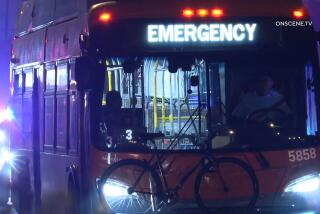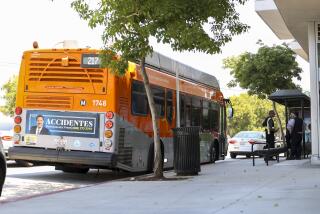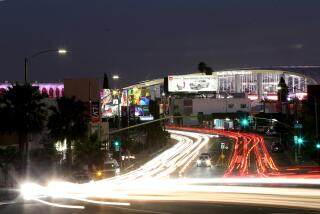Bill Would Ease Way for Transit Zone
- Share via
In the recent debate over the proposed San Fernando Valley transit zone, the facts got left at the curb.
There was little disagreement over the merits of establishing a zone itself, which would give local officials control of up to 27 bus lines now operated by the Metropolitan Transportation Authority.
But the devil is always in the details, and a simple policy goal can raise a host of thorny questions. How should the zone be structured? How would the bus drivers and mechanics already working in the Valley make the transition? Would they lose their jobs?
To address these concerns, representatives for drivers and mechanics sponsored state Senate Bill 372. Their proposal was based on a simple premise: Transit zones should provide employees the same protections the law requires of the MTA.
This idea didn’t sit well with some critics--particularly those eager to use the zone to put Valley bus service in private hands. These opponents began a lobbying campaign Chicken Little would have admired. They labeled the bill a transit zone killer although it was nothing of the kind. They claimed its passage would be a victory for the MTA bureaucracy, ignoring the fact that the MTA opposed the bill. They attacked MTA employees, offering wildly inflated claims about drivers’ salaries.
Ultimately, they turned on the proposed zone itself, claiming that new management would make no difference in Valley service. In their eyes, unless the zone was turned over to a private operator, it was destined to become a mini-MTA.
The hyperbole made for some good headlines. The facts tended to get short shrift.
Despite all the clucking to the contrary, passage of the bill would make establishing a transit zone in the Valley easier. Under current MTA guidelines, the zone would have to cut Valley bus service spending by 15% just to get permission to operate. Half of the savings--7.5% of what’s now spent in the Valley--would be siphoned off by the MTA. An amendment I authored would bar the MTA from enforcing this absurd rule.
*
And let’s dispense with the myth that drivers are overpaid. Consider Mike Kalustian, who after nine years on the job expects to earn a little more than $40,000 this year. His luxurious lifestyle includes an apartment in Canoga Park and an aging Saturn that he drives to work.
And what a plum job it is. He starts as early as 3:30 a.m. and drives as late as 1 a.m.. He’s been cursed at by angry riders. Hoodlums once shot out the windows of his bus.
Because he’s a public employee, he’s required to work during emergencies and natural disasters, when private operators tend to shut down. Kalustian helped move veterans out of damaged buildings after the Northridge earthquake. During the riots, he shuttled police to deployment points throughout the city.
Like other drivers, Kalustian works a good deal of overtime. It’s all scheduled by MTA management, which has allowed the ranks of drivers to thin remarkably over the years. Of the 25 drivers in Kalustian’s class of trainees, only three remain on the job.
In short, if you think Kalustian and his co-workers are what’s wrong with the MTA, you just missed the bus.
If there’s a cushy bus deal to be had, it’s the one private companies get to operate bus lines for the MTA. To start with, the MTA provides the buses at no cost to the company. For providing a driver, gas and maintenance, the MTA pays private companies more than $50 for each hour of service, five times the hourly pay of a starting MTA driver.
A Valley transit zone--established under the public-private partnership envisioned in SB 372--could change things. I firmly believe that proper local oversight could lead to significant improvements, because Valley leaders would be far more focused on serving our communities than the MTA’s vast bureaucracy.
Overhead could be reduced. Innovative management--either public or private--could redesign schedules to reduce forced overtime for drivers, using the savings to improve service. We can do that without losing the benefits of keeping public transit a public enterprise, and without hurting working families.
I know the MTA would prefer to give transit zones carte blanche to pursue privatization. I can’t help but recall, however, how the agency saddled itself with enormous debt over the years. Those debts weren’t built up paying drivers’ salaries. They came from lucrative private contracts to build boondoggle subways and a palatial downtown office tower.
Now the MTA claims that a new set of private contracts, to run bus service, is the only way to go.
Pardon me if I don’t go along for the ride.
More to Read
Sign up for Essential California
The most important California stories and recommendations in your inbox every morning.
You may occasionally receive promotional content from the Los Angeles Times.










